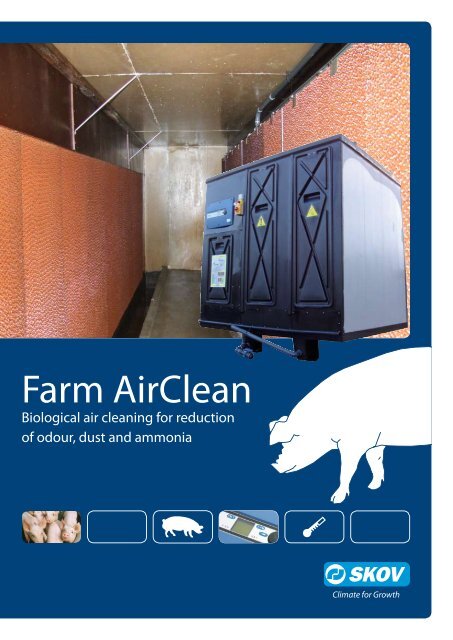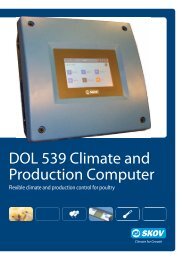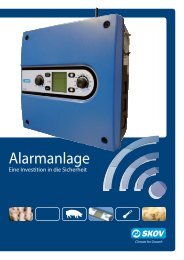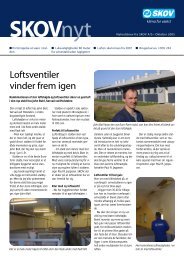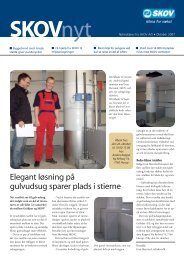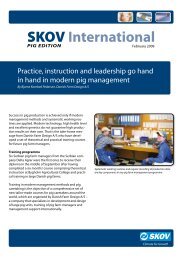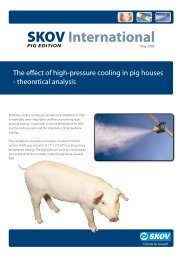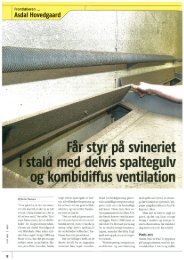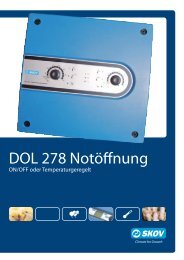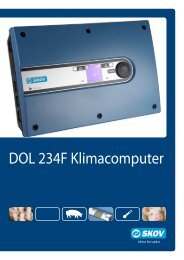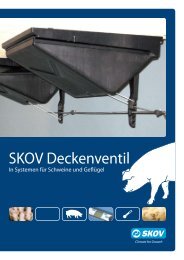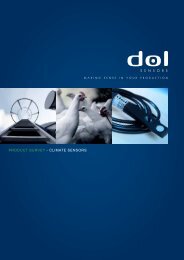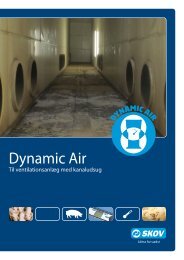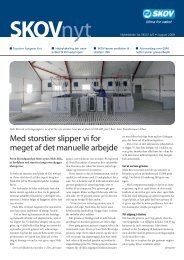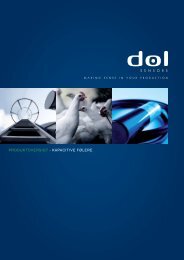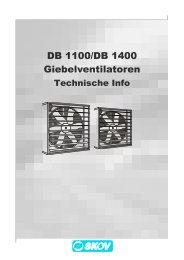Create successful ePaper yourself
Turn your PDF publications into a flip-book with our unique Google optimized e-Paper software.
<strong>Farm</strong> <strong>AirClean</strong><br />
Biological air cleaning for reduction<br />
of odour, dust and ammonia<br />
Climate for Growth
Efficient biological Cleaning of the outgoing Air...<br />
Ammonia, Odour and Dust<br />
The incentive to develop systems for<br />
cleaning housing air derives from the agricultural<br />
sector being under great national<br />
and international pressure to reduce its<br />
environmental load. For animal production,<br />
this involves requirements for a reduction<br />
of ammonia emissions, other nitrogen<br />
compounds, etc.<br />
This also applies to odorants from livestock<br />
houses. Producers are facing an increasing<br />
number of limitations when they wish to<br />
establish new house systems or extend<br />
them. These limitations often occur in the<br />
form of protests against the odour load.<br />
On several markets, the authorities have<br />
increased their focus on reducing the dust<br />
quantity discharged from the livestock<br />
houses to the surrounding environment.<br />
Recent research results have shown that<br />
dust from livestock houses can be disease<br />
carriers.<br />
<strong>Farm</strong> <strong>AirClean</strong><br />
<strong>Farm</strong> <strong>AirClean</strong> is a biological air cleaning<br />
system. The system is based on biological<br />
air-cleaning principles. These principles are<br />
effective in reducing odour, ammonia and<br />
dust.<br />
BIO Module or BIO Flex<br />
The <strong>Farm</strong> <strong>AirClean</strong> systems can be divided<br />
into two groups - BIO Module and BIO Flex.<br />
The air volume to be cleaned is crucial for<br />
the choice of system. The positioning of<br />
the air cleaner and the duct layout from<br />
the livestock house to the air cleaner can<br />
be factors as well.<br />
The BIO Module is used when the required<br />
air cleaning level is low and if the<br />
air cleaner is to be placed in the attic of<br />
the livestock house. BIO Flex is used when<br />
the required air cleaning level is high and<br />
if the air cleaner is installed inside or in an<br />
extension to the livestock house.<br />
In full-scale test, <strong>Farm</strong> <strong>AirClean</strong> has<br />
proven that<br />
•<br />
•<br />
•<br />
The ammonia content of the outgoing air is reduced<br />
down to 1 ppm<br />
The pig smell is eliminated from the outgoing air<br />
The dust content in the outgoing air is reduced by 90%<br />
A World of<br />
Customised<br />
Solutions
Only Water and indigenous<br />
Microorganisms...<br />
Patented Filter Construction<br />
The housing air is led through two filters<br />
sprinkled with water. Ammonia and<br />
odorants are removed in both filters while<br />
most of the dust is removed in the first<br />
filter.<br />
The air cleaning process is a biological<br />
process. Biofilms of bacteria and other<br />
microorganisms are formed on the filters.<br />
Ammonia, odorants and dust are removed<br />
when the housing air gets into contact with<br />
the water and the biofilm on the filters.<br />
Natural Cleaning by Microorganisms<br />
The effective bacteria and other microorganisms<br />
are indigenous in the livestock<br />
house environment. Some of the bacteria<br />
are specialists in converting ammonia.<br />
Microorganisms feed on the characteristic<br />
odorants from pig houses and dust. (e.g.<br />
root material and the pigs’ hide)<br />
The water re-circulates through the filters.<br />
When the water in the filters loses its<br />
capacity to convert more ammonia, it is<br />
Ammonia<br />
Odour of Pig<br />
Dust<br />
drained to the slurry tank and fresh water<br />
is supplied to the installation.<br />
The drained water, which is entirely biological,<br />
can be handled together with the<br />
slurry or spread directly on the fields as a<br />
fertiliser supplement.<br />
Only Principle that cleans the Air<br />
of both Odour and Ammonia<br />
The biological principle is the only air<br />
cleaning principle known to remove both<br />
odorants and ammonia from the outgoing air.<br />
A system based on chemicals can reduce<br />
the ammonia emission but has no effect<br />
on the odour emission.<br />
Approved System<br />
A worldwide patent for the <strong>Farm</strong> <strong>AirClean</strong><br />
principles has been applied for and the<br />
system is in operation in a number of<br />
countries around the world.<br />
On some markets, air cleaning is subject to<br />
approval by the authorities. <strong>Farm</strong> <strong>AirClean</strong><br />
is approved by the authorities in Denmark,<br />
Germany, the Netherlands, Belgium and<br />
Japan.<br />
Water<br />
Air Air<br />
Biofilm<br />
Ammonium<br />
Nitrit / nitrat<br />
Organc material<br />
Residual products can<br />
be spread<br />
together with slurry<br />
Kilde: Aron Saunders, Århus Universitet<br />
Ventilation and Air Cleaning<br />
from one Supplier<br />
Based on the system idea, <strong>Farm</strong> <strong>AirClean</strong> is<br />
a natural part of a SKOV ventilation system<br />
and thus optimised in every way.<br />
Furthermore, the customer only has to<br />
approach one supplier when the system<br />
is in operation. We know the correlation<br />
between ventilation and air cleaning and<br />
get the most out of the systems.<br />
CO 2<br />
Odour of wet<br />
forest floor
BIO Flex<br />
BIO Flex is designed to provide ’air<br />
cleaning by the metre’. The system is very<br />
flexible. Producers can optimise the<br />
investment and the operating costs in<br />
relation to the current regulatory requirements.<br />
Furthermore, the requirement for<br />
manual cleaning and maintenance has<br />
been minimised.<br />
BIO Flex is well suited for large air cleaning<br />
systems in connection with central channel<br />
and wall exhaustion.<br />
Flexibility at all Times<br />
BIO Flex is a biological air cleaning system<br />
- a two or three-step biological air cleaner<br />
- designed to provide ’air cleaning by the<br />
metre’. BIO Flex is characterised by:<br />
• Capacity ranging from 10 000 to 360 000<br />
m3 /hour with the same controller<br />
• Length of the system ranging from 2<br />
to 50 metres<br />
• Biological air cleaning<br />
• Optimum investment in relation to<br />
the regulatory requirements<br />
• Different levels of odour reduction<br />
(two or three filters)<br />
• Robust and reliable construction<br />
requiring only little maintenance<br />
In areas where regulatory requirements<br />
are in place (Germany), it is possible to implement<br />
a pH stabilization of the cleaning<br />
process.<br />
Minimum Maintenance<br />
It has been emphasised that the pig<br />
producer should spend as little time as<br />
possible on cleaning and maintaining<br />
the system. BIO Flex is equipped with a<br />
newly developed, patent pending robot<br />
washer (PA2010 00201). The design of the<br />
robot washer is sturdy and reliable and the<br />
robot washer automatically and effectively<br />
cleans the filters.<br />
1 2<br />
Stop
In addition, the utilization of the entire<br />
filter area in the air cleaner has been<br />
optimised and the quantity of dust in<br />
the filters has been reduced by placing a<br />
patent pending air distribution plate in<br />
front of the first filter (PA 2009 01023). The<br />
mechanical principle for sprinkling the<br />
filters under all operating conditions has<br />
been optimised so that the entire filter<br />
area retains the required humidification<br />
level.<br />
These additions improve the “working environment”<br />
for the bacteria in the system.<br />
This makes it easier for the bacteria to<br />
convert the odorants and the ammonia<br />
content in the housing air - and thus obtain<br />
the maximum cleaning effect.<br />
BIO Flex installation in Denmark<br />
Air distribution plate in front of the first filter<br />
Air outlet from the section to the air cleaner<br />
Automatic robot washer on the first filter<br />
Low Power Consumption<br />
BIO Flex is characterised by air cleaning on<br />
large filter areas which results in a minor<br />
pressure loss. The automatic robot washer<br />
and the dust reducing function of the<br />
air distribution plate are in combination<br />
to ensure that the filters are always in<br />
optimum condition and the pressure loss<br />
through the filters is low. The operating<br />
costs for ventilation have been minimised<br />
compared to other filter-based air cleaning<br />
systems.<br />
Control and Monitoring<br />
Optimum air cleaning with minimum resource<br />
consumption is handled by a DOL<br />
356 air cleaning computer. Operating data<br />
is collected and displayed by the <strong>Farm</strong>-<br />
Online® management system. Data documentation<br />
through <strong>Farm</strong>Online® meets<br />
the requirements<br />
of the<br />
international<br />
VERA Protocol.
BIO Modul<br />
The BIO Module is a module-based concept<br />
where the quantity of air cleaning<br />
units ordered is based on the number of<br />
m 3 of housing air to be cleaned.<br />
The idea behind the module-based filter<br />
unit was to standardise the air cleaning<br />
unit into prefabricated concept units.<br />
They are of a very high quality and thus<br />
ensuring the usual advantages: reliability<br />
and reduction of product manufacturing<br />
and mounting costs.<br />
The cleaning units are available in capacities<br />
ranging from 10 000 to 40 000 cubic<br />
metres per hour. For instance, the BIO 3U<br />
can clean 30 000 m 3 of air per hour, which<br />
is equivalent to approx. 300 finisher pen<br />
places according to Danish standards -<br />
calculation is based on approx. 100 m 3 air/<br />
hour/pig.<br />
Housing air<br />
Recirculated water<br />
Filter 1<br />
Biofilm<br />
Recirculated water<br />
By basing the system on modules, SKOV<br />
has made it easy for the pig producer to<br />
implement the system in the construction<br />
process. The cleaning modules can be<br />
placed in the attic, next to the house or in<br />
a cleaning room inside the house.<br />
Contrary to other module systems available<br />
on the market, this solution can be<br />
delivered either fully assembled or to be<br />
assembled on site. If the cleaning modules<br />
are to be installed in an attic, assembly on<br />
site can save the producer the removal of<br />
most of the roofing sheets in connection<br />
with the installation.<br />
Fan<br />
Filter 2<br />
Biofilm<br />
Floor<br />
Experience has showed that it is important<br />
to keep the filters clean. SKOV designed<br />
an automatic filter washer for the cleaning<br />
units. The washer starts at regular intervals<br />
and cleans the filter so it does not clog.<br />
DOL 256 Computer<br />
Each air cleaning module is equipped with<br />
a DOL 256 <strong>AirClean</strong> computer regulating<br />
the air cleaning process in this particular<br />
module. The decentralized control system<br />
ensures optimum cleaning of the individual<br />
section based on the actual requirement.<br />
The computer is very simple and the<br />
information level is confined to the data<br />
that the producer considers to be most<br />
important. On the computer display, the<br />
producer can see whether the controller<br />
is operative and the filter washer is active.<br />
The controller will show an overview of<br />
vital data such as water consumption,<br />
alarms and operation time. This data can<br />
also be shown in a 24-hour report or a<br />
year-to-date report.
Six BIO 2U modules installed next to a livestock house in Japan<br />
Module is lifted into position by a crane Module positioned in the attic<br />
Roofing completed and ventilation connected
kun er behov for en luftrenser med<br />
en kapacitet på ca. 10% af ventilationskapaciteten<br />
for at opnå en reduktion<br />
i ammoniakemissionen på 40%.<br />
Det svarer til det største reduktionskrav<br />
Partial gældende Cleaning for slagtesvinestalde<br />
med If the drænet pig producer gulv ved is required ansøgning to reduce om<br />
miljøgodkendelse the emission of ammonia, i 2009. partial Se tabel cleaning 2.<br />
Renseeffektiviteten could be an option. har dog en betydelig<br />
indflydelse, idet en luftvasker,<br />
der The kun largest kan reduction fjerne 50% of ammonia af ammoemisniakken,sion is achieved nødvendiggør in connection at ca. with 30% the<br />
af first ventilationskapaciteten 20% (0-20%) of the amount kan of ledes air<br />
gennem going through luftrenseren the air cleaner for at whereas opnå en<br />
tilsvarende the last 20% reduktion (80-100%) af do ammoniake-<br />
not add up to a<br />
missionen. huge environmental profit.<br />
henholdsvis høj og lav renseeffektivitet.<br />
Protect the Environment and save Money!<br />
Den SKOV største bases the renseeffekt air cleaning opnås on the step- ved<br />
rensning less outlet, af which op til is ca. running 20% in af a ventila- MultiStep<br />
tionskapaciteten, system. Then additional idet rensning outlets are af conen<br />
større nected andel to the kun air cleaner resulterer until i the en ammomarginalnia reduction reduktion required af ammoniakemissio-<br />
by the authorities<br />
nen. has been achieved.<br />
If partial cleaning is applied, the system is<br />
not dimensioned to clean all the outgoing<br />
air; but perhaps 30-40 percent of the<br />
maximum amount of air. The filters do not<br />
have to be so big and a smaller quantity of<br />
air has to be moved. This reduces the price<br />
of both the investment and the operation<br />
costs. Most of the ammonia will be removed<br />
in winter and only on very few days<br />
during the summer not all the outgoing<br />
air will be cleaned.<br />
Concentrate the Efforts<br />
SKOV plans the location of the air cleaning<br />
units by the livestock houses with the<br />
greatest ammonia and odour emission.<br />
This way the customer is protecting the<br />
environment as well as saving money. This<br />
would typically be finisher or farrowing<br />
sections with drained floors. The customer<br />
can get the best air cleaning effect per<br />
cubic metre of air.<br />
Figur 2. Reduktion af ammoniakemissionen som funktion af kapacitet for en luftrenser med<br />
Figur_3_og_4.xls / Alle_95_50%_20C 03-07-2007<br />
Reduction Reduktion of af NH NH3 NH emission, %<br />
3 % %<br />
3<br />
SKOV supply climate and production management systems for animal<br />
production the world over. Our solutions are technologically advanced,<br />
user friendly and individually adapted to meet the needs of our customers.<br />
SKOV A/S • Hedelund 4 • DK-7870 Roslev<br />
Tel. +45 72 17 55 55 • info@skov.com • www.skov.com<br />
620061-20080627 . Print: SKOV A/S<br />
100<br />
80<br />
60<br />
40<br />
20<br />
act innovate cooperate<br />
0<br />
Luftandel gennem renser, %<br />
Final concentration 1 ppm<br />
Slutkoncentration1ppm<br />
Slutkoncentration 2 ppm<br />
Final concentration 2 ppm<br />
0 20 40 60 80 100<br />
Proportion Luftandel of air gennem through renser, cleaner, % %<br />
1/3 drained_1ppm<br />
drænet_1ppm<br />
25-49%fast_1ppm<br />
25-49% solid_1ppm<br />
1/3 drained_2 drænet_2ppm ppm<br />
25-49%fast_2ppm<br />
25-49% solid_2 ppm<br />
Effect of a reduction of the ammonia emission of a proportion of air through an air<br />
Figur 3. Effekt på reduktion af ammoniakemission af luftandel gennem en luftrenser med<br />
slutkoncentration cleaner with a final på henholdsvis concentration 1 og of 2 1 ppm. and 2 ppm respectively. Source: Grøn Viden (Green<br />
Knowledge) no. 47: Partial cleaning of ammonia in livestock house air. Faculty of Agricultural<br />
Science.<br />
Figur_3_og_4.xls / Alle_1_2ppm 03-07-2007<br />
Climate for Growth


